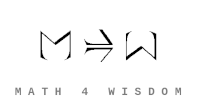- MathNotebook
- MathConcepts
- StudyMath
- Geometry
- Logic
- Bott periodicity
- CategoryTheory
- FieldWithOneElement
- MathDiscovery
- Math Connections
Epistemology
- m a t h 4 w i s d o m - g m a i l
- +370 607 27 665
- My work is in the Public Domain for all to share freely.
- 读物 书 影片 维基百科
Introduction E9F5FC
Questions FFFFC0
Software
Bott periodicity, Lie group embeddings, Linear complex structure, Clifford algebras, Topological invariants, Super division algebras
Relate linear complex structures with symmetric spaces.
Symmetric Spaces
- All of the symmetric spaces that I am interested consist of matrices. In each symmetric space, do all of the matrices have the same eigenvalues?
读物
- J.-H. Eschenburg. Lecture Notes on Symmetric Spaces This includes discussion of many examples, notably the complex structures on {$\mathbb{R}^n$}.
- Tobias Strubel. Basics on Hermitian Symmetric Spaces.
- Lizhen Ji. From symmetric spaces to buildings, curve complexes and outer spaces
- 11. Homogeneous and Symmetric Spaces
 Symplectic structure
Symplectic structure
 Generalized complex structure Generalizes complex structures and symplectic structures by considering their direct sum.
Generalized complex structure Generalizes complex structures and symplectic structures by considering their direct sum.
- Math Overflow. Examples of quotients of Lie group actions.
 Quotient space
Quotient space
Symmetric spaces and Bott perioidicity
Symmetric spaces
A symmetric space has, at each point, an isometry that maps each geodesic to the reflected geodesic. An isometry of a manifold is any (smooth) mapping of that manifold into itself, or into another manifold that preserves the notion of distance between points. The definition of an isometry requires the notion of a metric on the manifold.
A symmetric space has, at each point, a (global) isometry that (locally) inverts each tangent vector. Compare that with symmetry where we reflect across the center of a space.
The isometry expresses that we have all manner of twin choices.
Symmetric spaces include some quotients of Lie groups, however, not as groups but as manifolds.
Ideas
- Symmetric spaces - inversion is the symmetry of choice - like the symmetry in the binomial theorem.
- Symmetric spaces - those that undo any perturbation, thus make for stability.
Examples of Symmetric Spaces {$S$}
Grassmannian
- Grassmannian can be thought as defined on center at x as it moves in a manifold and yields tangent spaces.
- Freudenthal magic square organizes not just Lie groups but also symmetric spaces. Yong Dong Huang. Thesis.
Complex structures on {$\mathbb{R}^n$}
Quaternionic structures on {$\mathbb{C}^{2m}$}
Real structures on {$\mathbb{C}^n$}
Complex structures on {$\mathbb{H}^n$}
Orthogonal group
Compact Lie group
Grassmannians: Projection model
Grassmannians: Reflection model
If {$H↪G$} is an inclusion of Lie groups then the quotient {$G/H$} is called a Klein geometry.
Grassmannians
Grassmannian G(4,2) has five Plucker coordinates (4 choose 2) minus 1. Because it is up to scaling, which gives an extra dimension. Four points on a circle - if two chords cross, they can be untangled in two ways. Cluster algebra and "mutations" by which one product is the sum of two products. Ptolemy theorem.
Classifying space
- Classifying space for U(n) is the complex Grassmannian.
- Classifying space for O(n) is the real Grassmannian.

